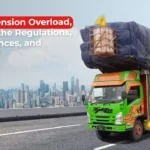Challenges and Solutions in Last Mile Delivery for Optimal Delivery
Posted on September 6, 2024 by Nur Wachda Mihmidati

In the growing world of e-commerce, last mile delivery has become a key focus for logistics companies and retailers. As the last stage in the supply chain, last mile delivery plays an important role in ensuring that products reach customers quickly and efficiently. However, the challenges faced in this process are increasingly complex, ranging from customers’ growing need for flexibility and transparency, to pressure to reduce carbon footprint. As consumer expectations continue to rise, it is important for companies to adopt innovative solutions that can improve efficiency and customer satisfaction with every delivery.
Case Study of Sustainable Solutions for Last Mile Delivery
DHL, a forwarder company, had a customer with an ambitious target to become a green company by 2030 by converting all home deliveries in 30 countries to electric vehicles (EVs) or other low-emission solutions by 2025. To achieve this goal, DHL conducted a comprehensive review of the electric vehicle market in the UK and Ireland, designed a vehicle and technology roadmap, and ran a four-week pilot program using two electric vehicles. Drivers also received special training to maximize the use of this new technology.
The results were very positive, with the trial reducing carbon emissions by 927 kg CO₂e from 272 customer deliveries. This demonstrates that transitioning to electric vehicles can have a significant impact on reducing carbon footprint, while still maintaining operational efficiency. With a successful pilot, DHL has demonstrated how low-emission logistics solutions can be an effective measure to support the environmental sustainability of customers and the industry as a whole.
In addition, DHL eCommerce also faces major challenges in providing sustainable last mile delivery solutions to its customers. One of the challenges was to provide transparency into the carbon footprint of shipments and reduce CO₂e emissions quickly and tangibly. To that end, DHL created a fossil fuel-free delivery solution powered by 1,400 electric vehicles and vans fueled by HVO100. This enables DHL to offer completely carbon-free delivery in some regions, with support from green electricity in certain areas. In addition, DHL is working with service partners to ensure even national coverage.
The results of this initiative are significant, with a reduction in CO₂e emissions of 25-30% in last mile operations. Not only is this approach being implemented nationwide without geographical distinction, but it is also accessible to all customers making consumer shipments. With this solution, DHL has positioned itself as a pioneer in sustainable shipping, creating a positive impact on the environment while providing consumers with full transparency into the carbon footprint of their shipments.
The Future of Last Mile Delivery
By 2030, last-mile delivery is expected to become more diverse with more sustainable and flexible solutions. The use of conventional delivery vehicles cannot continue to grow, making delivery segmentation essential. Electric vehicles, electric cargo bikes, and a network of easily accessible pack stations will be used to meet different delivery needs, depending on the type of goods, location, and customer demand. The main focus will be on creating a balance between cost efficiency and environmental sustainability, while ensuring customer satisfaction.
Sustainability will also become increasingly important, with electric vehicles and green fuels playing a major role in reducing carbon emissions. A dense network of pack stations will allow customers to pick up and return goods more flexibly, reducing the carbon footprint compared to direct home delivery. In addition, the development of autonomous pack stations that can move in areas with limited infrastructure will expand the service coverage and provide more choices to customers, creating a more efficient and environmentally friendly delivery system.
TransTRACK Solutions in Addressing LMD: Focus on Key Features
TransTRACK offers an end-to-end solution specifically designed to address the challenges of last mile delivery, providing greater visibility and efficiency for logistics service providers. One of TransTRACK’s leading features is real-time tracking, which allows logistics companies and customers to monitor the location of deliveries in real time. This feature helps improve first-attempt delivery success rates and minimize delays, ensuring a better customer experience. With the ability to accurately track vehicles, companies can proactively respond to route changes or traffic conditions.
In addition, TransTRACK has a route optimization feature, which uses artificial intelligence (AI) technology to create the most efficient delivery route based on distance, traffic, and weather conditions. This feature not only saves time and fuel, but also reduces overall operational costs and reduces carbon footprint. Furthermore, with the integration of delivery scheduling, customers can choose the delivery time that best suits their schedule, which increases flexibility and customer satisfaction. The combination of route optimization and delivery flexibility makes TransTRACK an innovative solution that is effective in improving operational efficiency and sustainability in the last mile delivery sector.
With a variety of advanced features offered, TransTRACK is the ideal solution to address the increasingly complex challenges of last mile delivery. From real-time tracking to route optimization and customization of customer preferences, TransTRACK not only improves operational efficiency but also provides a better delivery experience for customers. Join us in leveraging TransTRACK solutions to optimize your delivery process. With the right technology, you can increase customer satisfaction, reduce operational costs, and contribute to environmental sustainability. Contact us today for a free demo or consultation and see how TransTRACK can transform your last mile delivery!
Recent Post
Topic :
 Bahasa Indonesia
Bahasa Indonesia









